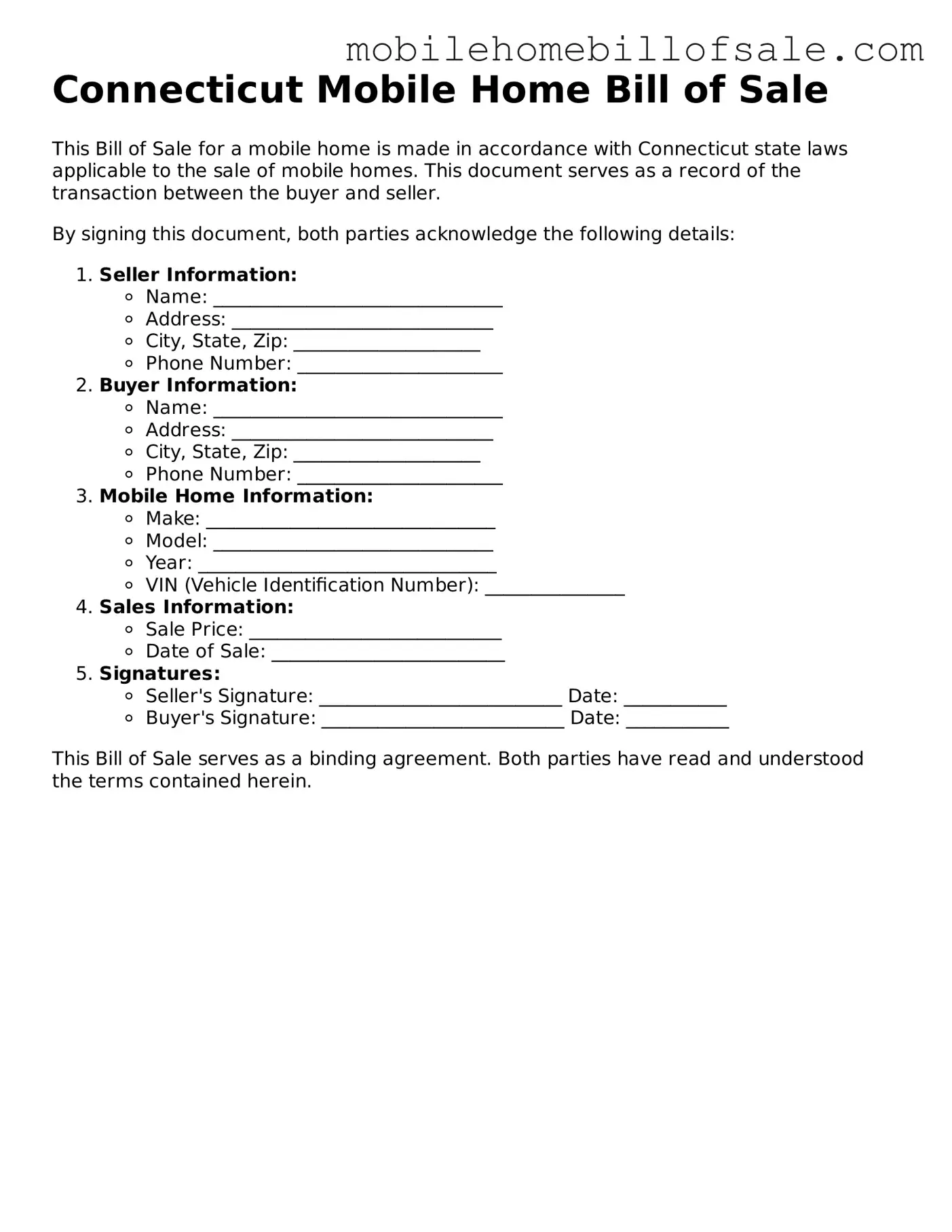The Connecticut Mobile Home Bill of Sale form shares similarities with a standard vehicle bill of sale. Both documents serve as legal proof of transfer of ownership from a seller to a buyer. They typically include essential information such as the names and addresses of both parties, a description of the item being sold, and the sale price. In both cases, the bill of sale acts as a safeguard for the buyer, ensuring they have documentation of their purchase, while also protecting the seller by providing evidence of the transaction.
Another document that is comparable is the real estate purchase agreement. Like the Mobile Home Bill of Sale, this agreement outlines the terms of a sale, including the parties involved, the property description, and the purchase price. Both documents require signatures from both the buyer and seller to validate the transaction. However, while the real estate agreement often includes contingencies and conditions, the Mobile Home Bill of Sale is generally more straightforward, focusing on the transfer of ownership.
The personal property bill of sale is also similar to the Connecticut Mobile Home Bill of Sale. This document is used for the sale of various types of personal property, including furniture, electronics, and other goods. It serves a similar purpose in documenting the transfer of ownership and includes information about the item being sold, the sale price, and the parties involved. Both documents help to establish a clear record of the transaction, which can be important for future reference.
A lease agreement can also be compared to the Mobile Home Bill of Sale, particularly in the context of mobile homes that may be rented rather than sold. While a bill of sale transfers ownership, a lease agreement outlines the terms under which a mobile home is rented. Both documents require the identification of the parties and the property, but they serve different purposes. The lease agreement typically includes terms regarding payment, duration of the lease, and responsibilities of both the landlord and tenant.
The boat bill of sale is another document that shares similarities with the Mobile Home Bill of Sale. Both documents facilitate the transfer of ownership of a mobile home and a boat, respectively. They include details such as the description of the item, identification of the buyer and seller, and the sale price. Both serve as legal proof of the transaction and are often required for registration purposes with state authorities.
The livestock bill of sale is relevant in agricultural contexts and is similar in purpose to the Mobile Home Bill of Sale. This document records the sale of livestock, detailing the type and number of animals sold, along with the buyer and seller's information. Both documents serve to protect the interests of both parties in a transaction and provide a clear record of ownership transfer.
A firearm bill of sale also resembles the Mobile Home Bill of Sale in that it documents the sale of a specific item. This document includes information about the firearm, such as its make, model, and serial number, along with the buyer's and seller's details. Both forms serve as legal proof of ownership transfer and may be required for registration or legal compliance in certain jurisdictions.
The aircraft bill of sale is another document that parallels the Mobile Home Bill of Sale. It is used to transfer ownership of an aircraft and includes similar elements, such as the identification of the buyer and seller, a description of the aircraft, and the sale price. Both documents are crucial for establishing legal ownership and may be required for registration with aviation authorities.
Lastly, a business asset bill of sale can be compared to the Mobile Home Bill of Sale. This document is used when transferring ownership of business assets, such as equipment or inventory. It includes details about the assets being sold, the purchase price, and the parties involved. Like the Mobile Home Bill of Sale, it serves as a legal record of the transaction and helps protect the interests of both the buyer and seller.
